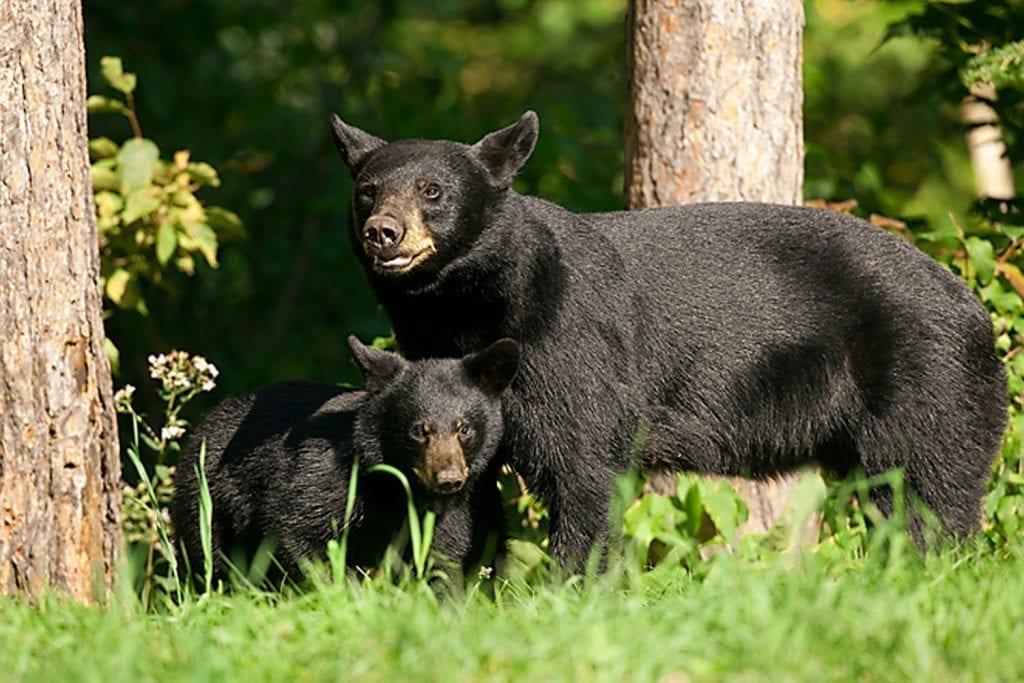Reducing Human-Bear Conflicts
Good housekeeping is a requirement wherever black bears are found. Simple sanitation measures can be the key to avoid attracting bears. Take responsibility for your safety and encourage your neighbors to do the same!
At Home:
- Remove bird feeders after April 1. New York’s black bears begin emerging from their winter dens in mid to late March. Bird feed such as suet and seeds are a very strong attraction for bears, even if they can’t reach it. Read more about bears and bird feeders.
- Garbage is extremely attractive to bears! It should always be kept in sealed garbage cans inside a sturdy building like a garage or shed. Anything with an odor can attract a bear. Note: Burning garbage is illegal and may increase its attractiveness to bears.

Bear resistant trash cans are used
all over the country to eliminate
human-bear conflicts.- If you frequently find bears foraging in your garbage cans, despite proper storage, consider using a bear-resistant trash container. View a list of bear-resistant products (leaves DEC website).
- Mask garbage odors with ammonia-soaked rags.
- If you have curbside garbage pickup– take out trash just before your scheduled pickup. Do not put garbage at the curb the night before.
- Do not place meat or bones in compost piles.
- Remove the grease can from grills after every use. Turn the grill on “High” for several minutes after you are done cooking to burn residual odors off the grill.
- Do not place food outside to attract wildlife. Any food items used to attract birds, squirrels, or other wildlife will also attract bears.
- Do not feed pets outside. Leftover food or even an empty dish can attract a bear.
- Do not operate refrigerators or freezers outside or on porches. Bears can smell what is inside.
- Electric Fencing is an effective tool for keeping bears out of apiaries, chicken coops, compost, and gardens.
While Camping:

Standard coolers are not bear-resistant!
Bears are intelligent and persistent, making
unattended coolers an easy target.
- Keep your campsite as clean as possible. Take all garbage and recyclables to the recycling center each evening.
- Do not leave coolers or food out at any time. Store them securely in either the trunk of your car or in the cab of your truck. Keep windows shut and food and coolers out of sight.Where food lockers are provided, food and coolers must be stored and locked inside. Standard coolers are not bear resistant.
- Bear resistant coolers are available for purchase or rent from many local, national, and web-based outdoor recreation retailers. View a list of bear-resistant products (leaves DEC website).
- NEVER keep food, coolers, or scented items in your tent. Do not wear clothing to bed that was worn while preparing or eating meals.
- Treat all toiletries as food items. Toiletry products are heavily scented and are as attractive to bears as actual food. Store toiletries securely with your coolers and food.
- Clean up after all meals immediately. Keep grills, pots, pans, cooking utensils, and wash basins clean when not in use. Do not wash dishes or leave food debris under the water faucets.
- Do not put grease, garbage, plastic diapers, cans, bottles, or other refuse into the fireplace. These items do not properly burn and will attract bears with their odors.
In the Backcountry:

- Use bear resistant food canisters. These are a highly effective means for preventing bears from getting your food, toiletries and garbage. Use of bear resistant canisters is encouraged throughout the Adirondack and Catskill backcountry, and are required in Eastern High Peaks Wilderness of the Adirondack Park.
- Pack a minimal amount of food. The less food to store the better. Use lightweight and dehydrated foods.
- Cook and eat before dark. Bears become more active after sunset.
- Cook away from your campsite. Choose an area at least 100 feet away from your sleeping area.
- Be neat and clean while cooking. Avoid spills and drippings. Do not pour grease into your fire pit.
- Keep food in storage containers. Only take out the food you plan to cook. Keep containers nearby and store food immediately if a bear approaches your cooking area.
- Avoid leftovers. Carefully plan your meals and eat all that you cook.
- Never leave food unattended. Bears may watch from a distance waiting for opportunities to steal food.

When using a food hang:
Use dark colored cord only as bears can more easily see lighter colored ropes and have come to associate them with a food source, in some areas. Cord should be 75 feet long and the bag should be hung 15 feet above the ground and at least 10 feet away from tree trunks.
Bear Fact Sheet for Backcountry Users (PDF, 32 KB)
Ours Noirs a l’attention des randonneurs (PDF, 75 KB) Version francaise
Handling Human-Bear Conflicts
The first priority in human-bear conflicts is public safety. DEC evaluates every scenario to determine the severity of the situation and to identify problem animals. Roughly 80% of bear problems are resolved over the phone with some simple advice, such as that listed above. However, some situations call for DEC Wildlife staff to go afield to assess or resolve the problem. These situations include bears causing serious property damage, entering homes or buildings, or bears that are in urban/suburban settings and cannot find an escape. In such cases, DEC applies the following protocol:

Relocation and hazing of bears is only
part of a temporary solution. If the food
attractant remains, other bears will find
the site and the human-bear conflicts
will persist.
- DEC assesses the situation and provides guidance to the homeowner on how to encourage the bear out of the inappropriate setting. The majority of actions involve removing food sources that are attracting bears or excluding bears from access to such sources.
- DEC may decide that the best course of action is to “negatively” condition a nuisance bear. These bears will be trapped and hazed upon release at that location in hopes of teaching the bear that obtaining food near humans is unacceptable. DEC tags bears that it handles so it can keep track of repeat offenders, which influences future decisions, should a problem bear have further encounters with people.
- Relocation is very rarely successful, and is therefore very rarely used as a management tool. A relocated nuisance bear often travels great distances, as much as 100 miles, to return to the original site, or will seek out new human food sources in the vicinity of its relocation site. Furthermore, if the food source remains at the original location, other bears will continue to be attracted to that site.
- Some bears repeatedly return to urban and suburban areas. As an animal becomes more comfortable in residential areas and loses its fear of humans, it may persistently seek out food sources around the community and become a more serious nuisance.
- Euthanizing a bear is always a last resort. DEC will exhaust all possible options before making a determination that a bear is a threat to public safety.
- Placing a black bear at an animal sanctuary is very difficult as most zoos and sanctuaries have too many bears already and will not accept more. DEC does not use this as an alternative.
DEC’s Black Bear Response Manual (PDF, 985 KB) outlines the response to various scenarios in which bears interact with people.
Remember: Bears are attracted by smells and many things smell like potential bear food. Remove the food attractant and you’ll remove the bear.
More about Reducing Human-Bear Conflicts:
- Bear Resistant Canisters – What are bear resistant canisters? How and why are they used?
- Black Bear Encounters – What to do if you encounter a black bear.
- Bears and Bird Feeders – Reduce bear attractants by taking down your bird feeder.



